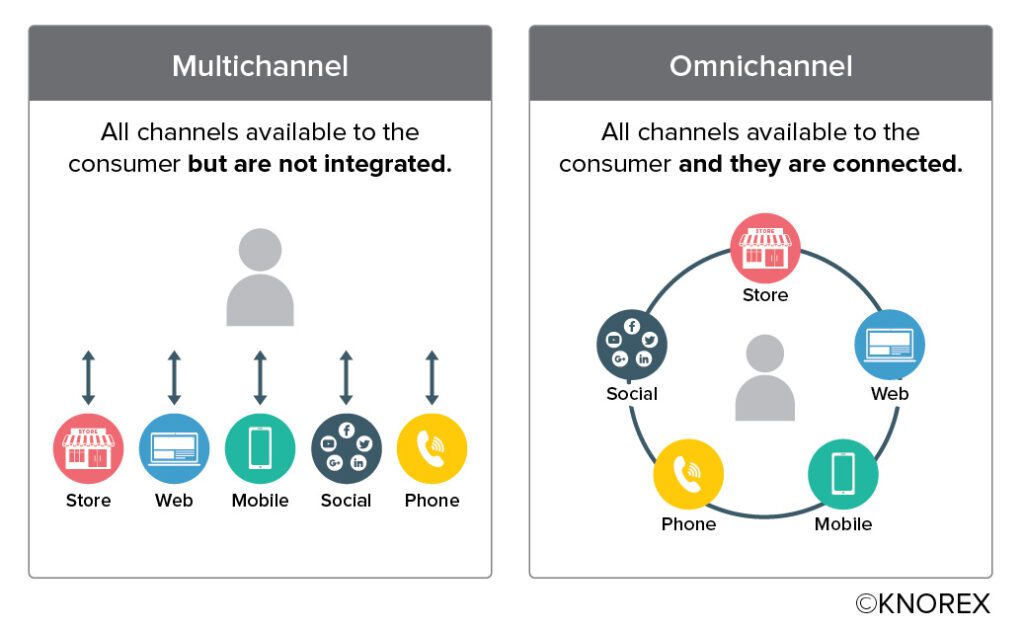The customer journey is a never-ending, non-linear narrative full of twists and turns.
The next generation of omnichannel marketing will help you understand how to navigate this complexity to find your customers when they’re ready to buy.
As consumers now have more options for shopping than ever, many businesses are struggling to keep up with the demands of today’s shoppers.
72% of consumers say they rarely… or never… have a positive shopping experience.
This is one reason why omnichannel marketing has become so important to brands – it aims to help companies make the most out of the multi-device world we live in.
One of the most important elements of a successful omnichannel campaign is understanding where consumers are in their journey, and how to reach them when they’re ready to buy.
In this article, you’ll discover more about the future of omnichannel marketing, including what technologies will help you connect with your customers, how to effectively use omnichannel data, and why messaging is so important in today’s multi-device world.

What is Omnichannel Marketing?
Omnichannel marketing is all about integrating your marketing across multiple channels at once – to have a better understanding of and engagement with potential customers.
Some omnichannel techniques include:
Cross-channel personalization: Using one, consistent brand experience across all customer touchpoints.
Cross-channel tracking: Connecting various customer data streams to one central store.
Cross-channel attribution: Establishing a causal impact between all touchpoints throughout the customer journey.
Here’s an example of what omnichannel marketing can look like in practice.
Marketers have tried for years to combine offline and online advertising, but it’s been difficult to measure the effectiveness of these efforts.
Omnichannel marketing, however, can help you understand whether customers are going from a TV ad to your website and making a purchase there.
This allows you to track customer journeys across channels and make more accurate calls about future purchases on new devices.
The Challenges of Omnichannel Marketing
Although companies are already using omnichannel marketing to try and reach customers in today’s multi-device world, it’s going to take a bit more time for marketers to figure out the best strategies.
According to new research, 60% of marketers say that their company is not set up well enough to effectively offer an omnichannel consumer experience.
Many also say they don’t understand how to use data from different channels to make the best decisions.
Another major issue for companies is that consumers expect a seamless, consistent brand experience when they move from one device to another.
They want this experience no matter what medium or channel they are engaging with at the time, and they’re more likely to defect from a brand that doesn’t offer it.
How Companies Can Prepare for the Future of Omnichannel Marketing
When trying to understand how omnichannel works, many brands look at today’s multi-device consumers to get inspiration for future strategies.
According to new data from McKinsey & Company, today’s consumers are more likely to have multiple devices with them at all times.
They’re also more likely to use these devices for a variety of purposes, including both work and play.
This behavior is changing the way we shop, interact socially, and even form political opinions.
Smartphones have driven a trend toward mini-moments – short, fairly superficial interactions with brands that consumers might have while they are moving from one thing to another.
Five years ago, companies only had two opportunities to interact with customers: when they were in a store or when they received a direct mail piece.
But today customers can get a company’s message at any point throughout the day.
It’s important to understand how consumers are using their devices and which ones they prefer for different purposes.
This will allow you to create deeper interactions with your audience, instead of trying to reach them in one-off moments.
What Consumers Expect from Omnichannel Marketing
Although marketers are still figuring out how to create a truly omnichannel experience, the customers they are trying to reach have already figured it out.
According to new data from Signal, 59% of consumers think that cross-device tracking is essential in today’s multi-device world.
Another 35% say that companies that use their data to create a seamless user experience will have the edge in five years.
Many also want companies to give them one brand identity across all of their devices.
This is something marketers can offer through consistent design, messaging, and functionality.
Consumers also expect omnichannel marketing strategies to be personalized based on what they are interested in.
71% say that they expect brands to provide relevant messaging and data, even when the user is not logged in or interacting with the company.
This means marketers will have to learn how to deliver messages through a mix of channels.
The Future of Omnichannel Marketing
Omnichannel marketing is already starting to change the way companies interact with consumers.
According to the Accenture study, 61% of respondents said that they were impressed by a brand that offered them personalized content on different channels.
Another 55% said they felt more loyal to a company if its marketing was proactive about delivering information across channels at the right time.
This is already happening to some extent. For instance, consumers who are not logged into their social media accounts can still receive messages from companies on Facebook and Twitter.
But omnichannel is just the beginning of a new era in marketing.
As we continue to move from physical interactions toward online interactions, it will be easier for brands to create cross-device strategies and deliver personalized messages.
This trend will also increase the competition among brands for mobile users’ attention.
To win over this valuable audience, companies must understand how cross-device marketing can create a truly omnichannel experience and meet consumers’ needs today while still looking toward the future.
How to create a successful Omnichannel Marketing Campaign?
1. Good User Experience
The user experience of your website is one of the most important aspects when running an omnichannel campaign.
By offering a consistent user interface that will transfer across all channels, you’ll be able to offer a seamless experience for your customer – even if they are using different devices at once!
Once again, it’s super important to create a good user experience for each device.
For example, it’s still important to optimize your site for mobile phones.
Customers are more likely to make purchases on their phones – so you’ll want to make sure that your site is designed well for this platform.
2. App-to-App Communication
For a truly successful omnichannel marketing campaign, it’s important to create a strategy that goes beyond your website.
That means creating app-to-app communication with the other apps that your customers use – like email and push notifications.
You can also get creative about how you engage your customer through their smartphone or tablet.
Online banking is an interesting example of this – companies like Bank of America have created a banking app that delivers banking-related push notifications (like when your credit card is being used) to customers who use the app.
So, don’t be afraid to get creative in how you reach out to your customers on their devices!
3. Be Proactive with Messaging
Customers will expect that you’ll reach out to them on multiple channels – whether you plan to or not!
That means you should be proactive about delivering messages across all of your platforms.
This is especially true if your customer uses more than one channel at once.
You want to make sure that everything is coordinated and that they are getting consistent information no matter where they are or what device they’re using.
Many companies already do a good job of this, but the trend will only continue to grow as more customers become accustomed to getting information through multiple channels at once.
4. Multilingual and Multi-Cultural Marketing in an international business.
You must reach out to your international customers.
One way to do that is with multilingual and multicultural marketing.
That means making sure that your website is translated into different languages, as well as having a strategy in place for reaching out to customers who speak other languages in the world market.
This can be particularly important if you’re targeting a country like China, where English is not the native language.
5. Personalized Mobile Messaging
The future of mobile marketing is personalized messages based on what your customer wants – and expects!
With a cross-device strategy, you’ll be able to send that personalized message via email, push notifications, text messaging, and more.
You have all the information at your fingertips about your customer’s preferences and behaviors – so why not use it to send them a message that will make an impact?
This ties directly back to the idea of creating mobile website updates.
Once you have their information, you can tailor your message there first, then use other channels as a way of reinforcing that communication.
6. Social Marketing
Social provides an avenue to market your business and engage in community marketing efforts.
Use these networks to create a presence where you can gain customer trust and share information about promotions, contests, news, and more.
It is important to keep up with the latest social media trends if you want your online marketing campaign to be successful.
Your customers are using these platforms – so you want to make sure that’s where you’re focusing your time and attention.
7. Mobile Billboards, Large Prints, and Banners
You may be wondering how something like mobile billboards or large prints can fit into an omnichannel marketing strategy. It’s very helpful!
Mobile billboards and large prints can be used to deliver an immediate message to your customer – especially if you’re targeting a local community.
They can help reinforce the messaging that you’re sending out via other channels as well, such as direct mail or email.
8. Digital Media Marketing
As part of your omnichannel marketing campaign, it’s also important to have a digital media strategy.
That means creating blogs, links, and social media accounts that are designed to reach customers through other channels in addition to their mobile phones.
These marketing tactics can be extremely helpful for building trust with potential customers, providing them with the information they need, and encouraging them to try your business or contact you.
9. Mobile Apps
You may also consider creating a mobile app, which will allow you to reach your customers through their phones or other mobile devices.
For instance, you could develop an app that gives users coupons or discounts for your business – then let them know about it via social media and text messaging!
Mobile apps can help build customer loyalty, make your business more accessible to customers, and allow you to provide them with valuable information when they need it.
10. Mobile Engagement Platforms
And finally, don’t forget about mobile engagement platforms like text messaging or chatbots!
These can help you build customer loyalty and satisfaction by sending out reminders or messages about the latest promotions, sales, or other information.
Engagement platforms are also great for listening to your customers, which is a key component of any omnichannel marketing effort.
While the idea of mobile marketing may sound like something that’s only for large companies, these concepts can be used by all types of businesses.
They just take a little bit of work and some creative thinking on your part to make them a reality.
The good news is that, if you’re willing to put in the time and effort, these tactics can help you reach customers across all channels – improve your SEO efforts, increase social media engagement, and even generate leads!
Do you have any questions about Omnichannel marketing? Leave me a comment.

Ali is a digital marketing blogger and author who uses the power of words to inspire and impact others. He has written for leading publications like Business2Community, Inc. Magazine, and Marketing Profs. When not writing, he enjoys spending time with his family.
